| Image | Class | Description | Fleet numbers |
|---|
| A class | Single truck, drop end, open California combination, built by Duncan & Fraser (1910–1911) for PMTT [1] : 49 | 1–20 |
| B class | Single truck, drop end, open California combination, built by James Moore & Sons (1917–1918) for PMTT [1] : 50 | 21–24, 84–91 |
 | C class | Maximum traction, bogie, drop end and centre combination, built by Duncan & Fraser (1913) for PMTT [1] : 51 | 25–35 |
| D class | Maximum traction, bogie, drop end and centre combination, built by Duncan & Fraser (1914) for PMTT [1] : 51 | 36 |
 | E class | Maximum traction, bogie, drop end and centre combination, built by Duncan & Fraser (1914) for PMTT [1] : 52 | 36–45 |
| F class | Single truck, straight sill, clerestory-roofed, single aisle summer car, built by Duncan & Fraser (1912) for PMTT [1] : 52 | 46–47 |
| G class | Single truck, straight sill, single aisle summer car, built by Duncan & Fraser (1913) for PMTT [1] : 53 | 48–53 |
 | H class | Single truck, drop end, open California combination, built by Duncan & Fraser (1913) for PMTT [1] : 54 | 54–63 |
 | J class | Single truck, drop end, open California combination, built by Meadowbank Manufacturing Company (1915) for PMTT [1] : 54 | 64–83 |
| K class | Single truck, drop end, open California combination, built by Moore (1919–1920) for PMTT [1] : 55 | 92–100 |
| L class | Bogie combination, built by James Moore & Sons (1921) for PMTT [1] : 56 | 101–106 |
 | M class | Single truck, drop end, open California combination, built by Duncan & Fraser (1917) for HTT and FTT [1] : 58 | 107–116, 183–189 |
 | N class | Maximum traction, bogie, drop end and centre combination, built by Duncan & Fraser (1916) for HTT [1] : 59 | 117–126 |
| O class | Maximum traction, bogie, straight sill, combination with one drop end, built by Duncan & Fraser (1912) for PMTT [1] : 60 | 127–130 |
 | P class | Maximum traction, bogie, drop end and centre combination, built by Duncan & Fraser (1917–18) for HTT [1] : 61 | 131–138 |
| Q class | Single truck, straight sill, closed combination, built by MMTB (1922–1923) [1] : 62 | 139–150, 190–201 |
| R class | Single truck, straight sill, closed combination, built by James Moore & Sons (1920) for FNPTT [1] : 63 | 151–153 |
| R class | Single truck, straight sill, closed combination, built by MMTB (1920) [1] : 63 | 172–176 |
| S class | Single truck, drop end, open California combination built by Duncan & Fraser (1916–1922) for MBCTT and MMTB [1] : 64 | 154–171 |
| T class | Single truck, drop end, open combination with long saloon, built by Duncan & Fraser (1917) for MBCTT [1] : 65 | 177–182 |
 | U class | Single truck, saloon, built by Duncan & Fraser (1906) for NMETL [1] : 66 | 202–211 |
| V class | Single truck, open cross bench, built by Duncan & Fraser (1906) for NMETL [1] : 67 | 212–216 |
| W class | Bogie drop centre combination, built 1923–1927 by Holden, James Moore & Sons and MMTB [1] : 23 : 112 | 219–418 |
| W1 class | Bogie drop centre combination, built by MMTB (1925–1928) [1] : 25 | 419–438, 470–479 |
 | W2 class | Bogie drop centre combination, built by MMTB and James Moore & Sons (1927–31) [1] : 26 | 439–458, 480–609, 624–653 |
 | W3 class | Bogie drop centre combination, built MMTB (1930–1934) [1] : 32 | 654–669 |
 | W4 class | Bogie drop centre combination, built MMTB (1933–1935) | 670–674 |
| CW5 class | Maximum traction, bogie, drop centre combination, built MMTB (1934–1935) [1] : 38 | 681–685 |
 | W5 class | Bogie, drop centre combination, built by MMTB (1935–1939) [1] : 35 | 720–839 |
| SW2 class | Bogie drop centre saloon, built by MMTB (1938, 1953, 1955) [1] : 37 | 275, 426, 432, 436, 478, 644 |
| | SW5 class | Bogie, drop centre saloon, built by MMTB (1939–1940, 840–849), converted by Metropolitan Transit Authority (1983–1986, all the other tram cars) [2] | 681–682, 721–734, 736–750, 752–755, 757–760, 764–765, 767–770, 773, 775–777, 780–781, 784–791, 793, 796–797, 800, 802, 805–812, 814–816, 818–819, 824, 828–830, 834, 836–838, 840–849 |
 | SW6 class | Bogie drop centre saloon, built by MMTB (1939–1951) [1] : 40 | 850–969 |
| PCC class (1950) | Two door bogie saloon, built by MMTB (1950) [1] : 42 | 980 |
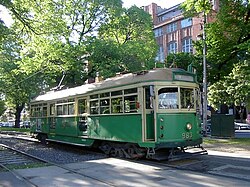 | W6 class | Bogie, drop centre saloon, built by MMTB (1951–1955) [1] : 43 | 970–979, 981–1000 |
 | W7 class | Two door bogie saloon, built by MMTB (1955–1956) [1] : 42 | 1001–1040 |
| W8 class | Bogie drop centre saloon, converted from SW6/W6/W7 trams 946, 959 (2013), 957 (2015), 1010 (2016), 983 (2017), 856, 928, 961 (2019), 888 (2020) [3] | 856, 888, 928, 946, 957, 959, 961, 981, 983, 1010 |
| X class | Single truck saloon safety car, built by JG Brill Company & St Louis Car Company (1923) [1] : 22 | 217–218 |
| X1 class | Single truck saloon, built by MMTB (1926–1928) [1] : 28 | 459–468 |
| X2 class | Single truck saloon, built by MMTB (1930) [1] : 30 | 674 (later 680), 675–679 |
| Y class | Bogie saloon, built by MMTB (1927) [1] : 29 | 469 |
 | Y1 class | Bogie saloon, built by MMTB (1930) [1] : 31 | 610–613 |
 | PCC class (1973) | Prototype two door bogie saloon, last ever tram built by MMTB (1973). [4] [5] Formed the basis of the Z1 class tram design | 1041 |
 | Z1 class | Two door bogie saloon, built by Comeng (1974–1978) [1] : 13 | 1–100 |
 | Z2 class | Two door bogie saloon, built by Comeng (1978–1979) [1] : 13 | 101–115 |
 | Z3 class | Three door bogie saloon, built by Comeng (1979–1984) [1] : 16 | 116–230 |
 | A1 class | Three door bogie saloon, built by Comeng (1983–1985) | 231–258 |
 | A2 class | Three door bogie saloon, built by Comeng (1985–1987) | 259–300 |
 | B1 class | Articulated saloon, built by Comeng (1984–1985) [1] : 19 | 2001–2002 |
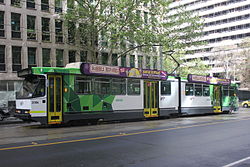 | B2 class | Articulated saloon, built by Comeng (1987–1994) | 2003–2132 |
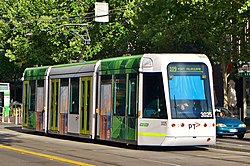 | C1 class | Three-section articulated saloon, low floor Alstom Citadis 202 tram(2001–2002) | 3001–3036 |
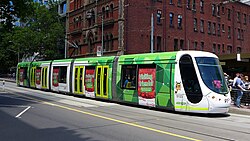 | C2 class | Five-section articulated saloon, low floor Alstom Citadis 302 trams (2008) [6] | 5103, 5106, 5111, 5113, 5123 |
 | D1 class | Three section, low floor Combino trams, made by Siemens (2002–2003) [7] | 3501–3538 |
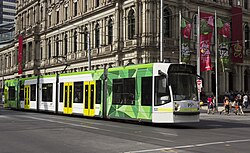 | D2 class | Five section, low floor Combino trams, made by Siemens (2003–2004) [8] | 5001–5021 |
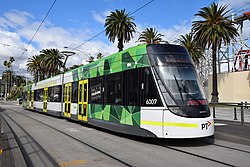 | E1 class | Three-section, four-bogie articulated trams built by Bombardier Transportation (2013–2017) [9] | 6001–6050 |
 | E2 class | Three-section, four-bogie articulated trams built by Bombardier Transportation (2017–2021) [10] | 6051–6100 |
 | G class | Three-section, low floor Flexity 2 trams built by Alstom (2025–) | 7001–7100 |






























